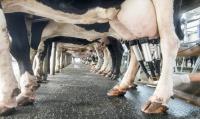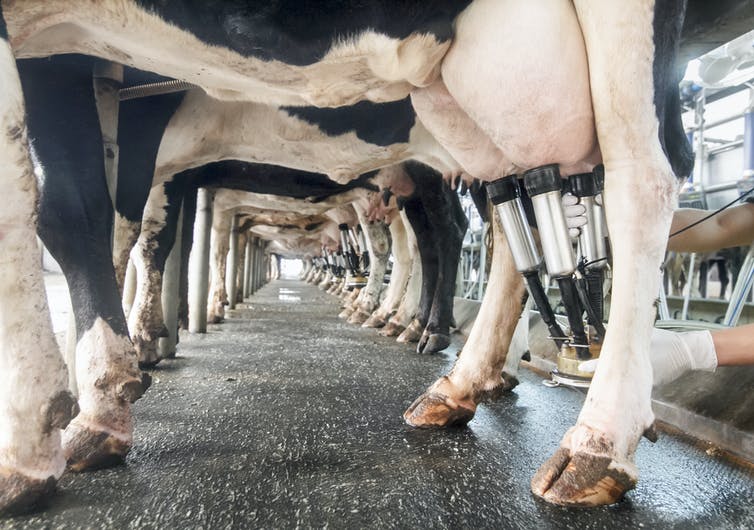This article contains spoilers for the film Cow (2021)
Cinema, according to the late critic Roger Ebert, is “a machine that generates empathy”. There is no film that better captures this truth than Andrea Arnold’s Cow.
Set on a British dairy farm, Arnold’s narration-free documentary captures four years in the life of a cow called Luma. The film opens with Luma giving birth to a daughter and ends with her being shot in the head at point-blank range with a bolt gun. In between, Cow documents the life-and-death cycle of the dairy industry.
The film captures routine dairy industry practices up-close, and it does not make for comfortable viewing. We see, for example, the horn buds of Luma’s calf seared with a hot iron. We’re also witness to the effects of repeated cycles of pregnancies and milking – coupled with selective breeding – on the bodies of dairy cows. By the end of the film Luma can barely stand and her swollen, infected udders are clearly very painful. Before her unceremonious death, Luma looks like a physically and mentally broken being.
These harrowing scenes are sometimes punctured by happier moments of Luma exploring open pastures with her herd. This makes the film all the more poignant, reminding the viewer that cows are capable of joy as well as suffering.
Cow is first and foremost a case study into Luma’s life. Throughout the film the camera lingers very closely to her, capturing her facial expressions, bodily movements and interactions with her children. The audience is invited to get as close to a cow’s-eye view of the world as possible.
This is not a documentary about cows as an amorphous, undifferentiated mass, it’s about a particular cow, and to a lesser extent, her calves and the fellow members of her herd. In this respect, Cow follows on the hooves of Pippa Ehrlich and James Reed’s My Octopus Teacher and Victor Kossakovsky’s Gunda, which have an octopus and a sow as their respective protagonists.
This emerging trend in animal documentaries – to focus on the real lives of particular animals – is encouraging. It underscores that nonhuman animals are not fungible entities but unique individuals with feelings, relationships, goals, desires and personalities.
But Cow also serves as a damning critique of the dairy industry more broadly. Although conditions will differ from farm to farm, the film records routine, and near-universal practices: mother-calf separation, harmful selective-breeding and bodily mutilations like branding, ear-notching and dehorning, not to mention killing spent cows.
The fact that the footage from Cow is shot with the knowledge and permission of the farmers shows that this film does not depict aberrations or abuses, but rather, documents the inherent brutality of the dairy industry. There is no nice way to enforce reproductive servitude – something we’re usually able to avoid thinking about. Cow leaves viewers no such room for denial.
Cow confronts us with the logic of commodifying animal bodies. When sentient beings are turned into productive units and caught in the maw of economic exploitation, their lives will invariably be characterised by suffering, ill health and denied freedoms.
Exposing the limits of animal welfare laws
As a law scholar, I’m interested in the role that legal systems play in maintaining the subordinate and vulnerable status of animals – and how they can be changed to better protect them. In virtually all legal orders animals are classified as property, a necessary corollary of their economic exploitation.
Of course, animals are distinct from other forms of property. Unlike chairs, books and phones they are sentient beings with subjective experiences and lives that matter to them.
Legal systems recognize this through animal welfare laws. Regulations establish certain minimum standards of care for farmed animals. While these laws may reduce some of the worst excesses of animal suffering, they leave untouched the systems that generate the suffering in the first place.
Just as Cow illustrates the inherent brutality of the dairy industry, it also shows the limitations of current legal means of animal protection. There is growing recognition among animal law scholars and practitioners that animals need fundamental legal rights akin to human rights to protect them from institutionalized abuse.
This doesn’t mean animals should have the same rights as humans – merely that they should share basic rights to protect their fundamental interests, such as rights to life, bodily integrity and freedom from slavery and servitude.
Efforts are afoot to challenge the prevalent approach to animal law. New York State’s highest court will soon hear a petition – supported by myself and 35 other UK experts in animal law – to release a solitary zoo elephant called Happy to a sanctuary.
What makes this case novel is that it does not appeal to animal welfare laws, but rather, to a common law right to contest unlawful imprisonment. If the appeal is successful, it will be the first time a nonhuman animal is recognized as possessing at least one fundamental right traditionally reserved for humans.
The Northeast Dairy Producers Association has, among other US industry groups, opposed the petition on the grounds that recognizing this right would be a “gross interference in owners’ property rights”.
These dueling views of non-humans – as beings to be respected or resources to be used – reflect the crossroads we’ve arrived at as a species. With growing recognition that our dysfunctional approach is not only bad for other animals but also ourselves, there has never been a better time to reflect on how we want to relate to the rest of sentient life.




